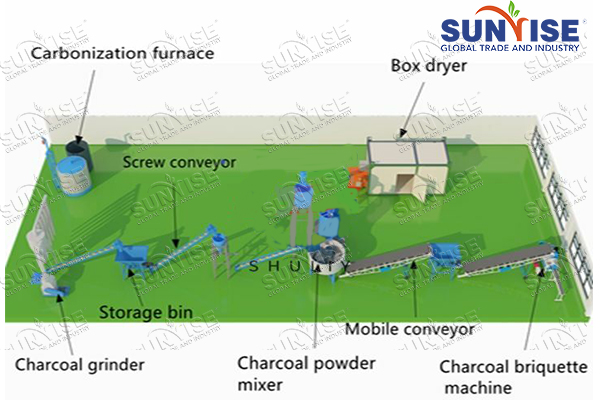Bamboo charcoal briquettes are an eco-friendly and efficient fuel source, crafted from the carbonized remnants of bamboo. These briquettes are increasingly sought after due to their sustainability, higher calorific value, and reduced environmental impact compared to traditional charcoal. To produce high-quality bamboo charcoal briquettes, specific machinery is required at each stage of the production process. Below, we explore the essential machines that facilitate this transformation.

Bamboo Crusher
The initial step in the production of bamboo charcoal briquettes involves the preparation of raw bamboo materials. A bamboo crusher plays a pivotal role in this phase by breaking down the bamboo into smaller, more manageable pieces. This machine efficiently reduces whole bamboo stalks into chips or fine particles, making the subsequent carbonization process more effective. By ensuring uniformity in size, the crusher sets the stage for optimal carbonization, which is critical for producing high-quality charcoal.
Carbonization Furnace
Once the bamboo is crushed, it undergoes carbonization in a carbonization furnace. This equipment is crucial for converting bamboo into charcoal. The furnace operates by heating the bamboo in an oxygen-deprived environment, typically at temperatures ranging from 400 to 600 degrees Celsius. This process removes volatile substances and transforms the bamboo into a stable carbon structure. Modern carbonization furnaces are designed to be efficient, with features that capture and recycle by-products like wood vinegar and tar, further enhancing sustainability.
Charcoal Grinder
After carbonization, the resulting bamboo charcoal may not be of uniform consistency. A charcoal grinder is used to mill the charcoal into a fine powder. This step is essential for producing consistent and high-quality briquettes. The grinder ensures that the charcoal is finely ground, which aids in the mixing process, allowing the binding agents to adhere uniformly.
Mixing Machine
The finely ground charcoal powder is then mixed with a binding agent, typically natural starch or clay, to prepare it for briquetting. A mixing machine ensures that the binder is evenly distributed throughout the charcoal powder, which is crucial for the briquetting process. This homogeneity ensures the briquettes have the necessary structural integrity and burn evenly.
Briquette Press
The final step in the production of bamboo charcoal briquettes involves the use of a briquette press. This machine compacts the charcoal mixture into uniform shapes and sizes, typically cylindrical or pillow-like. The press applies significant pressure to ensure the briquettes are dense and durable. High-quality briquette presses are often equipped with adjustable molds, allowing producers to customize the shape and size of the briquettes to meet specific market demands.
Conclusion
The production of bamboo charcoal briquettes is a multi-step process that relies on specialized machinery to ensure efficiency and quality. From the initial crushing of bamboo to the final pressing of briquettes, each machine plays a crucial role in transforming raw bamboo into a sustainable and versatile fuel source. By investing in the right machinery, producers can create high-quality bamboo charcoal briquettes that meet the growing demand for eco-friendly energy solutions. Visiting: https://www.char-molder.com/product/bamboo-charcoal-briquette-plant/
Leave a Reply